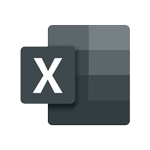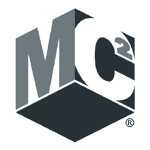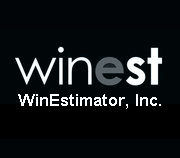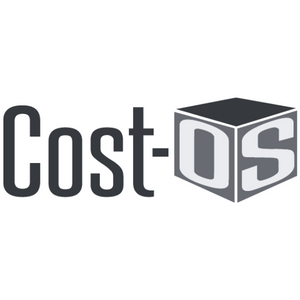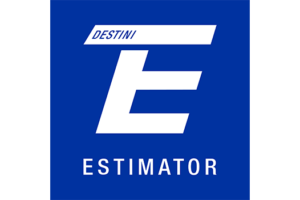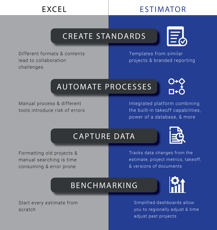What are the Differences in Construction Estimating Software?
The goal of construction estimating software is the same—generate an estimate to win a construction project. But not all cost estimating software is created equal. Some only feature one workflow, like takeoff or project management. Some aren't even true estimating software at all. Some are made for accounting teams and have been loosely stitched together so preconstruction teams can create estimates in them. And most of them don’t integrate with your other programs, so workflows are disconnected, and information isn’t passed back and forth easily.
So, how do you find the best construction estimating software and what do you look for?
To narrow down the differences, you need to compare the features of each offering and make sure the software you are looking for is robust enough to handle most, if not all, of your processes.
The biggest differences in construction estimating software are:
- Conceptual estimating
- Takeoff
- Data analysis
- Presentation
Conceptual Estimating
Conceptual estimating can be a slippery slope for any company. There are too many unknowns during this stage of a project. Preconstruction professionals are given slivers of project data and asked to spin off a number in their construction estimating software that gets within the ballpark of the actual construction costs.
Conceptual estimating is usually left to the most senior preconstruction professional because they have experience with the “unknowns” on numerous projects and know how much of a cushion to add to that guestimate before it is uttered in a project meeting. Yet, with the current environment, precon teams are having to rely on new and junior estimators to help fill the gaps of those senior estimators leaving the workforce.
Josh Walker, Senior Technical Product Specialist at Beck Technology, says, “The goal of our templates as we think of conceptual estimating is to allow us to have templates that are most likely market specific or can serve as a couple of market sectors, be able to build that once and be able to consume that over and over again.”
Construction estimating software with a strong cost history database, estimate templates, and transparent data sourcing can alleviate the sucker punch of conceptual estimating. DESTINI Estimator features estimate templates, so a new estimate is created quickly and easily by simply going through a series of short questions and refining the costs specific to the current project. These templates create a conceptual estimate with more realistic, defendable numbers.
Takeoff
There is takeoff software and there is construction estimating software. Very rarely are the two combined. (Spoiler alert: DESTINI Estimator combines them.) When construction takeoff and estimating are done on separate platforms, it creates a gap that allows errors to creep into the final estimate. Both copy and paste and manual data entry can be time-consuming and prone to errors. This leads to double the effort because a fine-tooth comb is required to double-check the data. Plus, the connection between where the quantities come from does not exist.
Construction estimating software with built-in takeoff capabilities reduces the simplest of errors from copy and paste or manual data entry. Beyond that clear benefit also comes the transparency of knowing where quantities come from and being able to not only pinpoint them in the estimate but also in the sheet and/or model. This transparency makes it easier for teams to collaborate as well as gives project owners the details they need with the confidence that the information provided is updated and accurate.
DESTINI Estimator’s unique 2D takeoff in its automatic pricing feature cuts your estimating time in half by applying costs while you are performing takeoff.
Check out DESTINI Estimator's integration with Togal.AI!
Data Analysis
Scope changes, design iterations, crew rates, fee adjustments … there is a litany of variables that get altered as a project moves through the preconstruction and construction processes. Being able to analyze every imaginable variable means precon teams are better equipped to make decisions on today’s projects as well as on future projects. We all want to make better and more informed decisions. The way we get better and become more informed is by analyzing what we have done to date. Too many construction estimating software are only pushing out estimates instead of helping construction companies become better and more informed.
GCs can become better and more informed in their decision-making through automated comparison charts of cost changes at each phase of a project, versioning estimates through various iterations, and seamless cost history tracking. Additionally, construction estimating software that has built-in data analysis as part of its purpose provides clarity to each preconstruction professional so they can lead and offer guidance on project decisions. Having that kind of knowledge quickly available at your fingertips is a differentiator.
Presentation
Whether it is creating a report, building a dashboard, or adjusting a custom view, it is great to have the flexibility to do so. When delivering an estimate branding and consistency are key to creating a great first impression (and keeping it). Building dashboards that combine the data that lives in preconstruction is also a boost to the visual appearance of a well-put-together project team.
Adjusting the construction estimating software view to either a layout that you are comfortable working in or a view that is optimal for project owners is vital to good communication. When construction estimating software does not value the presentation needs of a preconstruction team then winning a project is lost in the mayhem of jostling with reports, charts, and the real-time data changes that happen in project meetings.
Landon McQuestion, Director of Preconstruction and Estimating at Balfour Beatty says switching to DESTINI Estimator not only streamlined their estimating process but allows them to present professional and consistent deliverables to owners. He says, “The more standardized your estimates are, the more valuable and useful that information is.”
Preconstruction is a big part of the project pursuit process as well as keeping a project moving forward. Having visual functionality part of the construction estimating software be second nature removes the headaches of pushing and pulling presentation elements. Preconstruction professionals can focus on the estimate and high-value activities like data analysis.
The differences between construction estimating software can be the difference between winning and losing projects as well as the number of projects you are able to pursue. The difference in DESTINI Estimator saves you time. If the main purpose of construction estimating software is to create an estimate that will win a project, then the factors above should be closely considered as part of the winning elements. Otherwise, you are using software that just holds numbers instead of estimating software focused on not only winning work but growing your business.

-1.png?width=112&height=112&name=image%20(4)-1.png)





